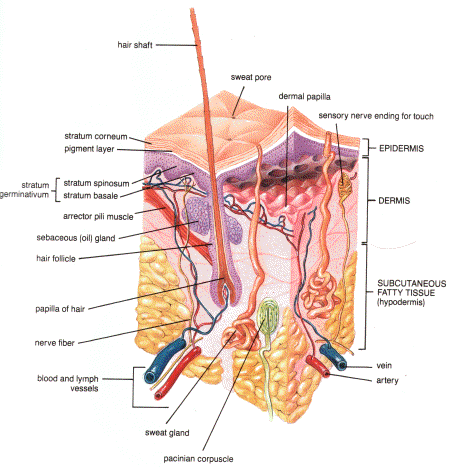
Common Skin Problems:
There are more than a thousand conditions that may affect the
skin but most skin diseases can be categorized according to nine common types.
· Rashes.
A rash is an area of red, inflamed skin or a group a individual spots. These can be caused by irritation, allergy,
infection an underlying disease, as well as by structural defects - for example blocked pores or malfunctioning oil glands. Examples of rashes dude acne, dermatitis, eczema, hives, pityriasis rosea, and psorasis.
· Viral infections.
These occur when a virus penetrates the stratum corneum and infects the inner layers of the skin. Example viral skin infections include herpes simplex, shingles (herpes zoster) and warts. Some systemic viral infections, such as chicken pox at measles, may also affect the skin. Viral infections cannot be
cured with antibiotics.
· Bacterial infections.
Such infections are caused by a variety of bacteria, the most common types being staphylococ streptococci. Bacteria may infect the topmost layers of skin, the follicles, or the deeper layers of skin. If not treated correctly,
these infections may spread throughout the body. Examples include impel folliculitis, cellulitis, and Lyme disease. Antibiotics are effective
against bacterial infections.
· Fungal infections.
Harmless fungi are always present on surface of the skin, and infection occurs when these organisms entry into the body These infections are usually superficial, affecting the skin, hair, and nails; examples include athlete’s foot, lock itch, and ringworm. However, in people with suppressed immune systems or who have been taking antibiotics long-term, the fungi may spread to deep within the body, causing more serious disease.
· Parasitic infections.
These infections occur after exposure to parasites such as lice and scabies.
· Pigmentation disorders.
The amount of pigment in the skin is determined by the amount of melanin being produced by the body Loss of pigment (hypo pigmentation) can be caused by an absence of melanocytes, malfunctioning cells, exposure to cold or chemicals, or some types of infection. An increase in pigment (hyperpigmentation) may be caused by skin irritation, hormonal changes, aging, a metabolic disorder, or another underlying problem. Age spots, freckles, and melasma are examples of hyperpigmentation; vitiligo is an example of hypopigmentation.
· Tumors and cancers.
These growths arise when skin cells begin to multiply faster than normal. Not every skin growth is cancerous: Some tumors are harmless and will not spread. Skin cancer is the most common of all the cancers, affecting 800,000 Americans each year. It is caused, in 90 percent of cases, by sun exposure. The three types of skin cancer are basal cell cancer (the most curable), squamous cell cancer (which may grow and spread), and malignant melanoma (the most deadly form). Prevention involves protecting the skin against damaging ultraviolet rays. Early detection helps to improve the chances of a cure, so regular self-examinations are recommended.
· Trauma.
Trauma describes an injury to the skin caused by a blow, cut, or burn. Any time the surface of the skin is broken, the body
becomes more susceptible to infection and disease.
· Other conditions.
Wrinkles, rosacea, spider veins, and varicose veins are among those conditions that cannot be neatly categorized. Wrinkles are caused by a breakdown of the collagen and elastin within the dermis, which results in sagging skin. Rosacea is a longterm disorder in which the skin of the face becomes red and develops pimples, lesions, and more rarely enlargement of the nose. Its cause is unknown. Spider veins and varicose veins become apparent when blood vessels enlarge and become visible through the surface of the skin.
|





 Today's random forum topics
Today's random forum topics
 What our customers are saying
What our customers are saying